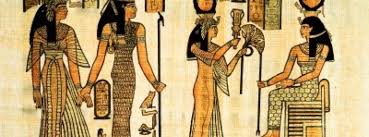
Humans and Herbs through Time ( an abstract from Diploma coursebook)
Share
I am currently in the middle of my studies for the Master Herbalist Diploma offered by https://www.onlineacademies.co.uk which I recommend to everyone wanting to help themselves and others with the power of herbs.
The paragraph below is just a small snippet from the first introductory chapter:
"Herbalists still believe in using the whole plant to treat people. Another reason is that plants are not conveniently standardized. One type of parsley may contain more vitamin C than another and other factors such as weather and soil conditions can affect a herb’s therapeutic value. Modern medicine isolates chemical compounds within the plant and recreates them synthetically.
Drug companies prefer to produce synthetic preparations so they can patent their formulation. It is not possible to patent a simple plant extract as it already exists in nature, so to make their money the drug companies must change it into something different!
Modern medicine has yet to better many of Mother Nature’s original healers, and the bases of most modern medicines lie in herbal remedies. There are currently more than 110 prescription drugs that are based purely on plant and herbal extracts. One of the most famous plant-healers is meadowsweet, which was first found to contain the aspirin compound acetyl-salicylic acid. Aspirin was first introduced in 1899 and named using the A of acetyl and SPIR from the original botanical name for meadowsweet. There are countless other examples: steroids and cortisone were first isolated from an East African sisal plant, meadow saffron (or autumn crocus) is the source of colchicine which is used against gout and cancer; foxglove is the source of heart disease drugs and the woolly foxglove is currently being used to treat cerebral malaria. Thrombosis can now be controlled by anti-coagulant drugs developed from melilot (or sweet clover), while the opium poppy produces powerful narcotic pain killers, including common codeine. Thorn apple is used against Parkinson’s disease and asthma, while the poisonous belladonna extracted from deadly nightshade is used to dilate pupils in sight-saving eye surgery. Feverfew is being successfully tested for uses in the treatment of migraine, ginger relieves the symptoms of nausea especially morning sickness and the oil from the seeds of the evening primrose are used to treat PMT and eczema.
Herbs are also an important part of homeopathy. This alternative medical therapy is based on the view that a disease can be treated by small amounts of a plant or other substance that can produce symptoms similar to the disease itself. Herbs used in common and highly effective homeopathic remedies include arnica for shock and bruising, bryony for dry coughs and pulsatilla for hayfever or catarrh.
The Hindu healing system called Ayurvedic medicine also relies on herbal remedies. Ayurveda acknowledges three ‘humours’ of wind, bile and phlegm, and ancient texts describe the use of over 700 plants to treat disorders. Diet is an essential aspect of Ayurvedic medicine, which is why Indian food uses many culinary herbs such as okra, caraway, cumin and other spices.
Herbs form an integral part of life in many cultures around the world. The Amazon Indians, who live within some of the densest vegetation, are literally surrounded by many herbal remedies. They eat the tuber-like roots of the yucca plant after removing the poisonous parts, make an alcoholic drink from the fruit of the palm a valuable source of B vitamins, wash themselves with plants rich in saponins (compounds that foam in water), and harvest tough river weeds to burn as fuel. They make a caffeine-rich drink from the bark of the forest liana, and eyewash brewed from the leaves of this woody vine is used to cure eye infections.
The Amazon is also the source of a potential wonder drug currently being developed to treat certain cancers. A substance called taxol has been used to reduce the size of breast cancer tumours. It is early days yet, but taxol is thought to work by blocking a mechanism of cell division. It is derived from a close relation of the English yew and has been described in clinical trials in the United States and France as one of the ‘most important advances in chemotherapy in recent times’. However, taxol comes from the bark of the Pacific yew, an endangered species, and removal of the bark kills the tree. Even if the plant extract is licensed there would never be enough to provide sufficient quantities to make the drug it takes three to six trees to treat one patient and each tree takes at least sixty years to grow before it can be used. The challenge is for the phytochemists to find other varieties of plants that contain similar compounds, or to find a way to mimic taxol synthetically.
Although the study of herbalism is as old as time, we still have a long way to go before we understand even a fraction of what herbs and plants have to offer. Fewer than 5 percent of an estimated 250-500,000 plant species have actually been examined for pharmacological activity. Modern medicine is only just beginning to investigate the scientific and medicinal properties of many forgotten plants that were used by healers in the past. As we discover more about the benefits of these exotic species we are likely to see an increasing use in herbal remedies and continue to benefit from their many powerful properties."